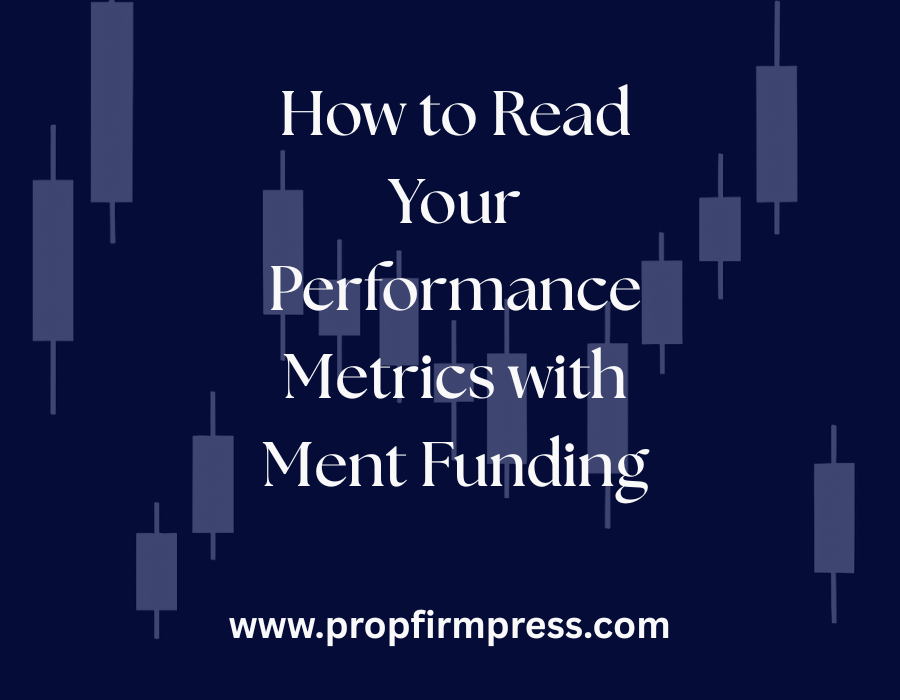How to Read Your Performance Metrics with Ment Funding
One of the most valuable resources offered by Ment Funding is its performance dashboard. This tool is the command center for traders, tracking progress, rule compliance, and trading consistency. But many traders underestimate how to read, interpret, and act on their performance metrics. This article walks you through each key metric and how to use it to increase your chances of passing the evaluation and staying funded.
Why Performance Metrics Matter
Metrics do more than track wins and losses—they tell a story about your risk, consistency, and discipline. Ment Funding’s evaluation system is based not just on hitting a profit target, but on how you achieve it. Reading your performance data allows you to:
- Spot bad habits before they blow your account
- Track if your risk-reward is improving
- Adjust your strategy based on real data
- Gauge readiness to scale up
Without understanding these metrics, traders fly blind and often repeat the same mistakes.
Key Metrics on the Ment Funding Dashboard
Let’s break down the most important metrics available to you once your evaluation is active:
- Balance: Your current account value. This includes closed trades only.
- Equity: Your real-time account value, including open trades.
- Drawdown: Tracks how much your account has decreased from its highest point.
- Trailing Drawdown: The highest balance reached minus the trailing threshold. This must never be breached.
- Profit Target: The amount you must reach to pass the evaluation.
- Daily Loss Limit: The maximum you can lose in one day. Exceeding this fails the evaluation.
- Consistency Ratio: Measures how consistent your profits are across trading days.
- Average Winning Trade vs. Average Losing Trade: Helps assess risk-reward ratio.
Each of these serves as both a benchmark and a warning system.
Understanding the Trailing Drawdown
This metric is one of the most misunderstood yet critical. Unlike a static drawdown that’s calculated from your initial balance, Ment Funding uses a trailing drawdown system that follows your highest realized balance.
Example: If your high-water mark is $52,000 and your trailing limit is $2,500, your drawdown buffer is down to $49,500. If your account falls below that, you fail—even if you’re still above the initial balance.
Always check this after winning days to reassess how much room you have left to trade.
Monitoring Daily Loss Limits
Going over your daily limit—even by a single tick—can result in disqualification. Use the dashboard to monitor:
- Open trade drawdowns
- Total daily losses across trades
- Pending trade size and potential risk
Staying under this limit is more important than hitting a big win.
Using Win Rate and Risk-Reward
Ment Funding displays your win rate as a percentage and your average win/loss ratio. Together, these form your trading edge.
Example:
- Win rate: 50%
- Average win: $400
- Average loss: $200
This gives you a positive expectancy, which is what you need to consistently grow the account.
If your win rate is high but risk-reward is poor (e.g., winning $100 and losing $300), you may need to adjust your strategy or stop-loss discipline.
Profit Curve and Equity Curve
The visual curve in your dashboard offers a quick glance at your trading health. A smooth, upward curve shows discipline. Sharp spikes or drops often signal overleveraging, revenge trading, or inconsistent position sizing.
Check for patterns:
- Do you lose on Mondays and win on Thursdays?
- Are your losses always following large wins?
- Are you improving or declining week to week?
Use the chart as a reflection of your emotional and technical discipline.
Number of Active Trading Days
Ment Funding requires a minimum number of active trading days to pass the evaluation. Don’t try to rush your way to the profit target in two or three trades. Spread your wins out and be active on the required number of sessions.
Traders often forget this and hit the target early, only to stall waiting for the calendar to catch up. Stay active with micro-lots if needed while you wait.
Consistency Score: What It Means
This score evaluates whether your performance is relatively even across your evaluation. Huge one-day wins and small follow-ups can negatively impact this score, even if your total profit is high.
Ment Funding is looking for traders who can produce stable results, not lottery winners. Aim to keep daily PnL within a consistent range and avoid one-hit wonders.
How to Audit Your Metrics Weekly
- Start by checking your drawdown buffer. Do you have room to risk tomorrow?
- Review win rate and risk-reward. Are you improving?
- Check the profit curve. Is it trending up or dipping recently?
- Evaluate whether you’re nearing the consistency or daily limits.
- Note what time of day your winners and losers occur.
This self-audit keeps you objective and aware of what’s working and what isn’t.
Final Tips for Using the Dashboard
- Take screenshots of your dashboard weekly to track progress over time.
- Use the data to make rules for yourself (e.g., stop trading after 3 wins).
- Don’t obsess over every fluctuation—look for trends and behavior patterns.
- Pair dashboard insights with journal notes for context.
Take Action with the Data
Your performance metrics are only useful if you use them. Don’t just glance at your balance. Study the dashboard like a coach reviews game footage. With smart interpretation, your Ment Funding performance metrics can become a playbook for passing your challenge and building long-term funded success.
